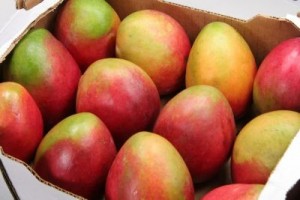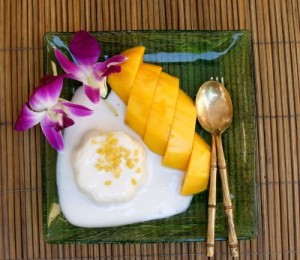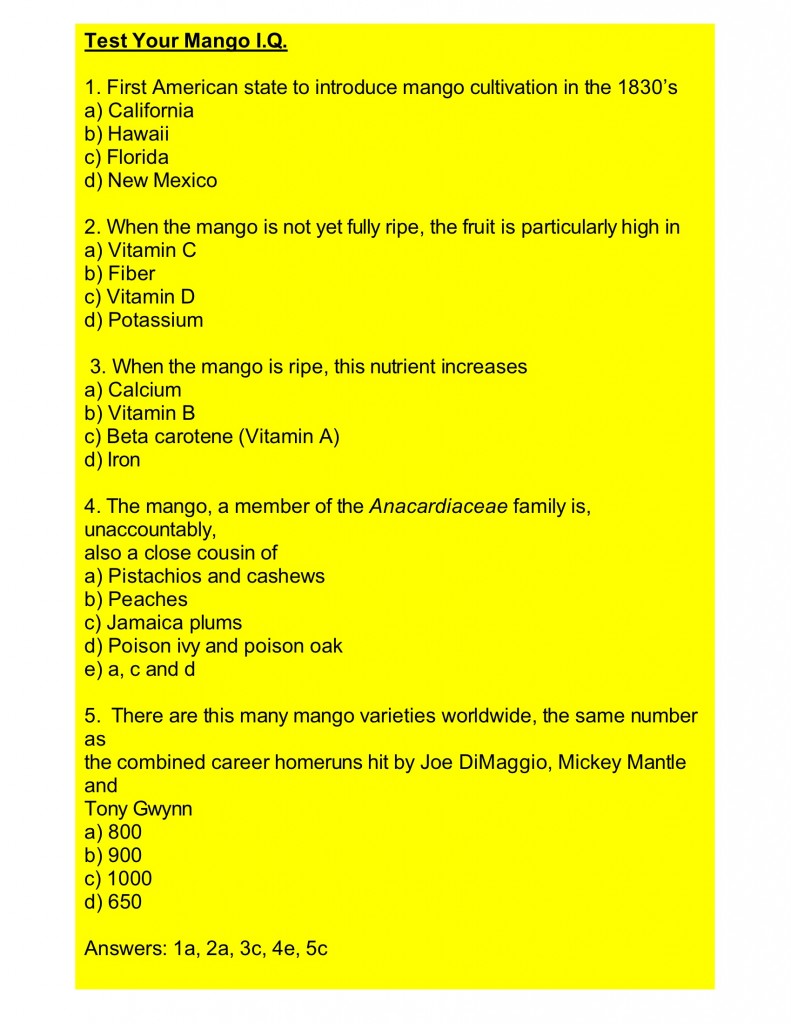By Catharine L. Kaufman—a.k.a. The Kitchen Shrink
As soon as I turn into the produce aisle, my nose takes over and pulls me past the fruits and veggies on my shopping list, straight to a large spill of fragrant mangoes. Fair warning: even mango connoisseurs find it difficult to choose their take-home specimens from among the  various size and multicolor beauties that range from golden kidney-shaped ones that fit comfortably in an average palm, to the hefty juice-bundles that mimic parrots with their green-to-pink-to-wine-red skins. Time and my dinner-cooking plans vanish, crowded out by an overwhelming desire to sink my teeth into the plump mango flesh and, with utter disregard for table manners, let the sweet nectar drip down my chin. Yumm!
various size and multicolor beauties that range from golden kidney-shaped ones that fit comfortably in an average palm, to the hefty juice-bundles that mimic parrots with their green-to-pink-to-wine-red skins. Time and my dinner-cooking plans vanish, crowded out by an overwhelming desire to sink my teeth into the plump mango flesh and, with utter disregard for table manners, let the sweet nectar drip down my chin. Yumm!
Of course, I usually collect twice the assortment that would satisfy my family of four, but always make up for my folly by buying half the amount of other fruits on my list. Fortunately, mangoes keep quite well and can be prepared in various ways—all mouth-watering delicious. But whether you slice, slurp, warm or chill it for salad, desert, drink or side dish, or combine it with other ingredients for a spicy chutney to serve as a condiment with meat, fowl or fish, the mango never fails to impress.
Mangoes have been delighting palates for centuries. India eventually became the leading grower of mango trees—which is revered and believed to possess the power to grant wishes, while the fruit is a versatile and much favored national staple. This and the country’s large population are probably the reasons that most of India’s mango production is absorbed by its domestic consumers, while the rest of the world’s appetite for this exotic delicacy is satisfied by exports from Mexico, Brazil and South Africa.
 Fruity Facts: Mangoes originated in East India and Burma, emerging from obscurity around the 5th century B.C. when Buddhist monks sang their praises to everyone, from Malaysia to other parts of Eastern Asia.
Fruity Facts: Mangoes originated in East India and Burma, emerging from obscurity around the 5th century B.C. when Buddhist monks sang their praises to everyone, from Malaysia to other parts of Eastern Asia.
Today, with 20 million metric tons of this international favorite grown throughout countries with tropical climes, more fresh mangoes are eaten all over the world than almost any other fruit.
Medicinal Mango: High in fiber, with a sturdy skin some people consider edible, the mango fruit consists of a juicy flesh (mesocarp) and a large, hard pit (endocarp). Although its leaves are toxic if ingested and the sap can cause dermatitis, every part of the mango tree from the bark and skin to the flesh and pit have been for centuries, and continue to be used in folk remedies that treat or prevent a wide range of ailments. The various compounds derived from this plant have been found helpful for their anti-viral, anti-parasitic, anti-asthmatic, cough suppressant, laxative, cardio-tonic, contraceptive and even aphrodisiac properties.
Nutritional Mango: The fruit is loaded with Vitamins A and C, the afore-mentioned fiber, antioxidants and potassium, with additional benefits provided by its low fat, calorie and sodium content. Mangoes also contain a digestive enzyme similar to the papain found in papayas.
“Mango Tango” & Other Tropical Treats: A versatile food, the mango is a fine companion to appetizers, soups, entrées and deserts. It  can also be enjoyed on its own for snacks or add-ons to hot or cold breakfast cereals. Try it fresh, frozen or in dried strips; blended in smoothies, tossed in oatmeal or baked in muffins, breads, cobblers or pies. Purée it to top your ice cream or sorbet; chunk it to decorate a cake; blend it with herbs and spices into chutneys and salsas for dips or to accompany chicken, duck or fish; and remember that it can also be cubed and tossed into seafood cocktails, tabouli or other salads or made into a to-die-for chilled soup. Serve mango in spicy risotto (preferably with organic brown rice). Bake it into cupcakes. And finally, make merry with mango margaritas, mango-tango daiquiris, pineapple and mango rum cocktails and mango martinis. (Have I left anything out?… Do click on the attached Comment button to add your mango recipes or suggestions—which we’ll be happy to include in the Recipes section of this blog, along with the one you’ll find below.)
can also be enjoyed on its own for snacks or add-ons to hot or cold breakfast cereals. Try it fresh, frozen or in dried strips; blended in smoothies, tossed in oatmeal or baked in muffins, breads, cobblers or pies. Purée it to top your ice cream or sorbet; chunk it to decorate a cake; blend it with herbs and spices into chutneys and salsas for dips or to accompany chicken, duck or fish; and remember that it can also be cubed and tossed into seafood cocktails, tabouli or other salads or made into a to-die-for chilled soup. Serve mango in spicy risotto (preferably with organic brown rice). Bake it into cupcakes. And finally, make merry with mango margaritas, mango-tango daiquiris, pineapple and mango rum cocktails and mango martinis. (Have I left anything out?… Do click on the attached Comment button to add your mango recipes or suggestions—which we’ll be happy to include in the Recipes section of this blog, along with the one you’ll find below.)
How to Pick a Winner: Although you’ll see mangoes popping up on your grocers’ shelves as early as April, patience will be rewarded
with juicier, meatier and sweeter versions if you wait for their peak season in June and July. Just make sure to catch up with your mango craving before it disappears in September.
To select a winner, start with your nose, inhaling the sun-baked, perfumed and slightly fruity scent. Next, eyeball the fruit as you would a diamond. Then, engage your sense of touch by turning it every which way in your hand to make sure it is free of soft spots, blemishes or bruises. Now squeeze a bit and choose the mangoes that have a slight ‘give.’ Colors depend upon the variety—Hadens ripen to a tie-dye combo of raspberry, orange and yellow, while the Ataulos mangoes glow with a buttery yellow hue. Some species stay green even when perfectly ripe. Mangoes should be kept at room temperature for about a week after purchase—providing you picked from a newly arrived batch at the market. If you need them to ripen quicker at home, just place the fruits in a paper bag and check them daily. Once ripe, mangoes are ready to eat—or to store in your refrigerator’s produce bin or a low shelf, where they usually keep quite fresh for up to two weeks. Frozen, dried, cooked or puréed, they last much longer.
If your mouth isn’t watering yet at the thought of a mango, whip up this divine salsa and dial up the flavor of your next seafood or chicken dish with it. Added bonus: Good doses of Vitamins A and C, as well as plenty of potassium to replenish some fluids lost to summer heat or vigorous exercise.
Sweet and Savory Mango Salsa:
2 cups fresh mango, chopped
1/2 small red onion, diced
1 cup diced Persian cucumber
3 sprigs fresh cilantro (optional), chopped
Juice from one fresh lime
Sea salt and cayenne pepper to taste
In a mixing bowl combine the ingredients. Refrigerate and enjoy with blue corn chips or as a condiment on sandwiches, burgers, grilled fish or other dishes.

2 Comments on “Mango Mania”
Pingback: How many calories in a mango
Pingback: How many calories in a mango